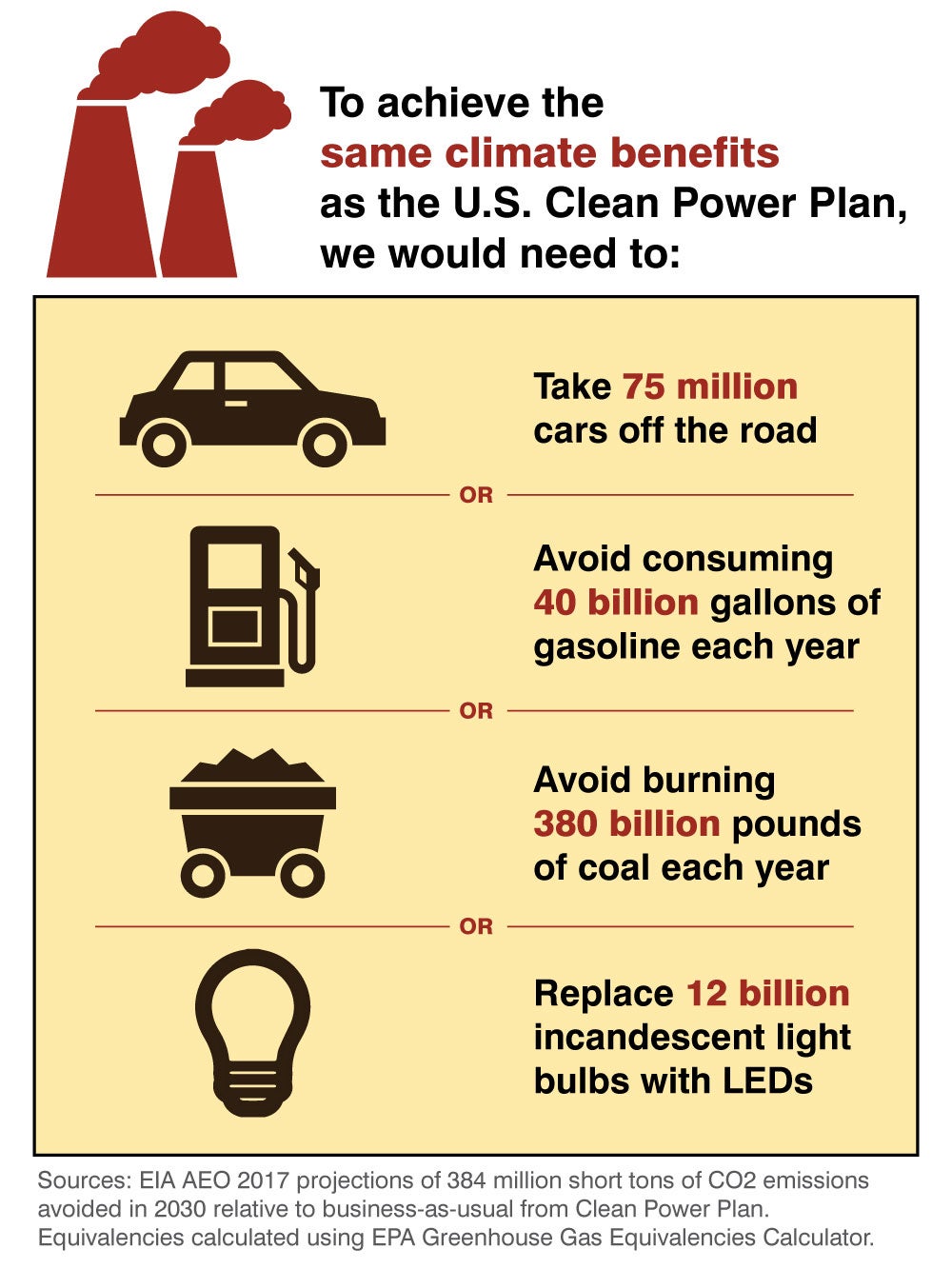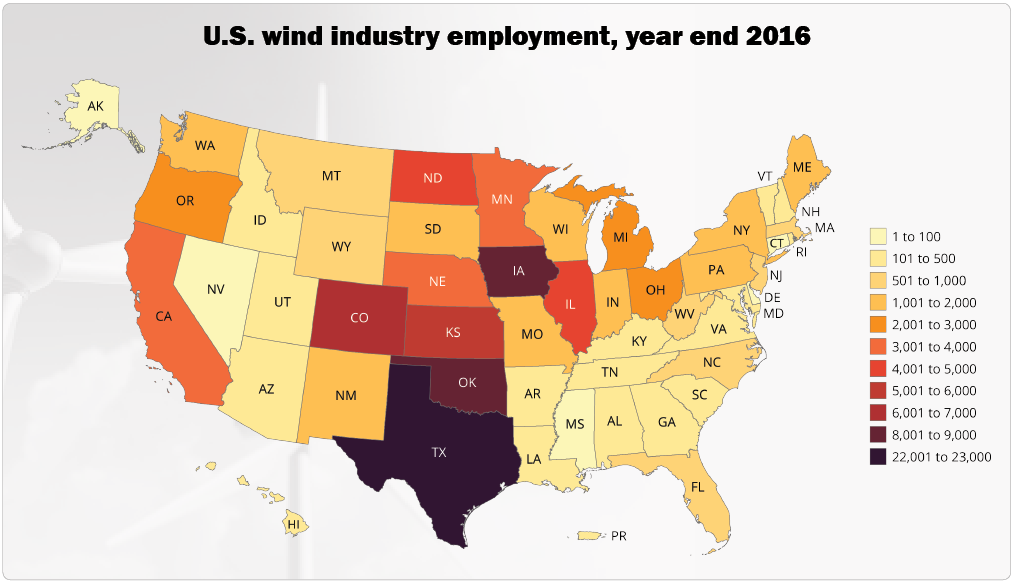 (EDF’s Ben Levitan co-authored this post)
(EDF’s Ben Levitan co-authored this post)
Environmental Protection Agency (EPA) Administrator Scott Pruitt says he will sign a proposal tomorrow to repeal the Clean Power Plan – America’s only nationwide limits on carbon pollution from fossil fuel power plants.
If the proposal matches what we’ve already seen in a leaked draft, it would be one of the most deeply harmful and reckless actions an EPA Administrator has ever taken. It would cost thousands of American lives, harm public health in myriad other ways, and lead to years of costly delays in combating the urgent threat of climate change.
Administrator Pruitt would have to go to great lengths to obscure and ignore these harmful consequences. When EPA issued the Clean Power Plan in 2015, it estimated that the plan would create up to $54 billion in annual benefits, including:
- The prevention of up to 3,600 premature deaths every year
- The prevention of 90,000 childhood asthma attacks every year
- The prevention of 300,000 missed school and work days every year.
By comparison, EPA concluded that the annual costs would be much lower. And in the two years since the Clean Power Plan was issued, new analyses – including this one from New York University’s Institute for Policy Integrity – have concluded that compliance with the Clean Power Plan has become dramatically cheaper as a result of the plummeting costs of clean energy.
Yet the draft proposal for repealing the Clean Power Plan seems to rely on a significantly higher costs estimate, and much lower benefits. How is that possible?
A careful look at the numbers shows that the Administrator Pruitt’s EPA cooked the books for this proposal. They used discredited methodologies to artificially inflate costs, and to mask the consequences for our climate and obscure the thousands of lives that could be lost as a result of their repeal of the Clean Power Plan.
Here are four tactics that Administrator Pruitt has employed in the leaked proposal to inflate the costs and hide the benefits of the Clean Power Plan:
1. Disregarding lives saved by the Clean Power Plan
EPA’s original analysis of the Clean Power Plan found that it would avoid thousands of premature deaths each year by reducing particulate matter pollution – yielding up to $34 billion in annual health benefits in 2030.
According to the American Lung Association, particulate matter pollution causes permanent damage to lung development in children, aggravates asthma and other respiratory problems, increases hospitalizations, and increases deaths from heart and lung diseases including lung cancer.
The Clean Power Plan would reduce exposure to this pollution across the country – avoiding these health harms and premature deaths.
Administrator Pruitt’s draft proposal assumes away those benefits by asserting – contrary to established medical research – that there is zero health impact from reducing particulate matter pollution below certain “threshold” levels. The proposal also suggests that EPA can count only the climate benefits associated with carbon pollution, with no consideration to any health benefits at all.
This claim that there is a “threshold” level of particulate pollution below which it does not harm human health is directly contradicted by the American Heart Association and was completely discredited many years ago by an expert panel convened by EPA under the George W. Bush Administration. It also runs contrary to EPA’s long-standing practice.
As EPA itself recently explained in a court brief:
The best scientific evidence, confirmed by independent, Congressionally-mandated expert panels, is that there is no threshold level of fine particulate pollution below which health reductions are not achieved by reducing exposure.
Ignoring the deaths and harm to Americans’ health that would result from repealing the Clean Power Plan is unconscionable. The plain truth is that undoing the Clean Power Plan would deprive Americans of billions of dollars in health benefits and put then at increased risk for premature death.
2. Artificially inflating the costs of the Clean Power Plan
EPA originally anticipated that parties would comply with the Clean Power Plan in part through investments in demand-side energy efficiency, “a highly cost-effective means” for reducing carbon pollution from the power sector.
Demand-side energy efficiency measures help consumers save electricity, resulting in lower electric bills for hard-working Americans, less pollution, and a more reliable electric grid. Investments in energy efficiency are largely offset by the electricity savings that result.
Yet the upside-down accounting in the draft proposal adds those energy efficiency investments to the costs of the Clean Power Plan without deducting the electricity savings those investments yield. This makes it look like the power sector is paying for both energy efficiency and the electricity that it no longer needs to produce. Therefore, this upside-down accounting includes billions of dollars of imaginary electricity costs – for electricity that will never be generated or purchased.
The draft proposal adds the cost of this imaginary electricity to its estimate of Clean Power Plan benefits — to represent the “benefit” of not having to purchase electricity that was never produced in the first place. When comparing costs and benefits, this imaginary electricity is a net wash – but it enables EPA to inflate its estimate of the plan’s costs by up to $19.3 billion in 2030.
The draft proposal also uses a higher discount rate of 7 percent for energy efficiency investments – providing no meaningful justification for a choice that further inflates costs by $6.2 billion.
The cumulative effects of adding the cost of imaginary electricity and using a higher discount rate increases costs by up to $25.5 billion in 2030.
3. Shortchanging the benefits of reducing carbon pollution
Administrator Pruitt’s proposal aggressively undercuts the social cost of carbon. That’s the estimate of damages that climate pollution causes for our families and communities – from more intense hurricanes and heat waves, more wildfires, and the many other threats of climate change.
By using an unrealistically low figure, the proposal severely undervalues the benefits of the Clean Power Plan’s carbon reductions.
The original Clean Power Plan utilized an estimate of the social cost of carbon developed over many years by experts from a dozen federal agencies who used the best available science and repeatedly considered public input.
The draft proposal for repealing the Clean Power Plan has new, misleading values that use unsound methods rejected by independent experts to yield a lower estimate of the Plan’s benefits.
The draft proposal simply ignores important categories of carbon reduction benefits
The new proposal claims to count only the domestic U.S. impacts of carbon pollution, even though this pollution causes worldwide harm. A recent report by the National Academy of Sciences affirmed the importance of counting global benefits, explaining that the benefits of reducing carbon pollution would be dangerously undervalued if every country used a domestic-only social cost of carbon.
The draft proposal’s “domestic-only” cost estimate also ignores significant harms to the U.S. that arise from climate change impacts in other countries – including “global migration, economic destabilization, and political destabilization,” and “[l]ower economic growth in other regions [that] could reduce demand for U.S. exports, and lower productivity [that] could increase the prices of U.S. imports.”
For these reasons, the National Academy of Sciences concluded earlier this year that:
Climate damages to the United States cannot be accurately characterized without accounting for consequences outside U.S. borders.
Administrator Pruitt’s approach flies in the face of that expert advice.
The draft proposal short-changes our children by discounting pollution reduction benefits for future generations
The new proposal also uses a sharply lower value for the benefits that today’s carbon reductions provide to future generations.
The original Clean Power Plan “discounted” the future benefits of carbon reductions at a rate of three percent per year, based upon the findings of the inter-agency working group.
But the new proposal uses discount rates as high as seven percent, without any justification – a value that is much higher than recommended by the National Academy of Sciences or the economics literature.
The cumulative effects of ignoring global impacts and increasing the discount rate are dramatic. In the original Clean Power Plan, EPA estimated climate benefits of $20 billion in 2030 (using a three percent discount rate). The draft proposal to repeal the Clean Power Plan estimates climate benefits of just $0.5 billion in 2030.

Click to enlarge
4. Ignoring how low-cost clean energy means the Clean Power Plan will be even more affordable
In the two years since EPA finalized the Clean Power Plan, the plan’s goals have become even more achievable and low-cost than originally projected – thanks to electricity sector developments including the sharply declining costs of renewable energy.
But the new draft proposal has made no attempt to update its economic analysis, and does not appear to acknowledge that recent studies of the Clean Power Plan have found compliance costs are now much lower than EPA originally estimated.
Instead, Administrator Pruitt is proposing to repeal this life-saving, economically beneficial public health protection before even bothering to properly consider the latest data.
The recent report from the Institute for Policy Integrity highlights the falling costs of complying with the Clean Power Plan and points to several power sector developments that explain this trend.
The report presents several recent economic analyses conducted by independent, non-governmental entities that estimate substantially lower compliance costs than EPA projected in 2015. For instance, a June 2016 analysis by M.J. Bradley & Associates, using the same electric sector model as EPA but updating several inputs, finds that compliance would cost up to 84 percent less than EPA originally estimated.
EPA recognized and evaluated many of these precise studies as part of its Clean Power Plan deliberations. Yet for the sake of repealing the Clean Power Plan, Administrator Pruitt has decided to ignore these studies.
America deserves better
The Clean Power Plan is the most significant step the U.S. has ever taken to address the crisis of climate change. Once fully implemented, it will provide enormous public health benefits – making Americans safer, healthier, and more productive.
If Administrator Pruitt is intent on rolling back a life-saving protection for human health and the environment, the American people at least deserve an honest evaluation based on the best available data.
Unfortunately, it looks like he’s using underhanded maneuvers and deceptive accounting gimmicks to justify rescinding the Clean Power Plan instead – and the consequences for the health and safety of Americans will be all too real for decades to come.











 (EDF’s
(EDF’s 



